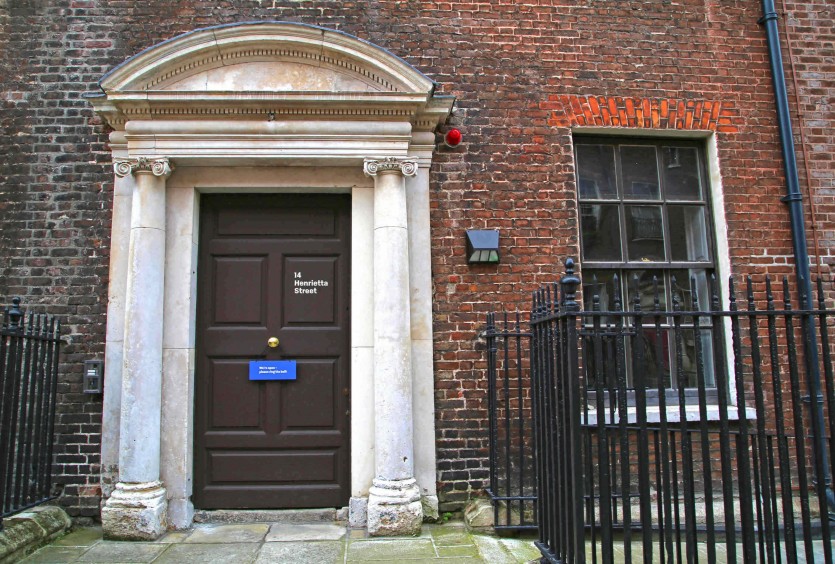Kevin Barry and Henrietta Street
StoriesPublished 28 October 2020

Kevin Barry and Henrietta Street
14 Henrietta Street is delighted to welcome historian Donal Fallon to write a series of blog posts about the building and its rich and varied history.
Today, Donal considers the history of the Irish revolutionary, Kevin Barry.
The centenary of the hanging of Kevin Barry, 1 November, is fast approaching.
Barry remains one of the most romanticised figures of the Irish revolution, with The Ballad of Kevin Barry performed and recorded by acts as diverse as Paul Robeson and Leonard Cohen. Barry, recalled in song as “just a lad of eighteen summers”, was born on Dublin’s Fleet Street in 1902, but he is associated with and commemorated at a number of sites in Dublin’s north inner city.
A graduate of Belvedere College, Barry’s image is to be found within the school today, while only a short distance from 14 Henrietta Street, at the intersection of Constitution Hill and North King Street, a plaque marks the IRA ambush of 20 September 1920 in which Barry participated, his capture leading to his execution less than two months later.
Dissent on the city streets
Yet Henrietta Street itself features in the story of Barry’s short life, as he participated in a daring raid here in June 1920, as Volunteers raided the King’s Inns for arms and ammunition. Denis Holmes, a contemporary of Barry and a fellow participant in the raid, recounted that “the darting nature of the coup, which was brought off in broad daylight, created a great sensation at the time, especially as the King's Inns was an outpost to the British military position at the North Dublin Union close by."
Even today, the King’s Inns casts a reminder of British rule onto Henrietta Street, with the symbolic lion and unicorn, the Royal Coat of Arms, in the stonework of the building. With the republican movement seeking desperately to arm itself in the city by any means necessary in the summer of 1920, the King’s Inns armory was identified by the leadership of the IRA as likely to reap dividends. Holmes' abiding memory of the raid was Barry "coming out of the guardroom with a Lewis gun hugged in his arms."
Holmes recalled that the IRA had watched the King’s Inns for some time, as "our GHQ (General Headquarters) had learnt through the intelligence department that although the Inns were well guarded, military discipline was not so strict as it was in other outposts." The daring raid on King’s Inns involved other men mobilising in the vicinity of Henrietta Street, with Holmes recounting "a party in Henrietta Street … was standing ready to protect the men on the raid." Volunteers "formed a cordon across Henrietta Street, and did not leave their position until all our men had got safely away.”
Henrietta Street and its surrounding area witnessed considerable excitement in the period. A stone's throw away from the street, at Yarnall Street, the printing company Mahon’s was publishing the IRA newspaper, An tÓglach, the name Ardiff Mahon is still there over its door. IRA volunteer John Shouldice recounted Volunteers being mobilised to protect the printers from Dublin Castle detectives seeking to put the IRA publication out of action.
Young revolutionaries
By the time of his involvement in the King’s Inns raid, young Kevin Barry’s studies in the National University - now University College Dublin - were beginning to suffer. Exactly three months on from the raid, he participated in a nearby IRA raid for arms at Monk’s Bakery, mere minutes walk from Henrietta Street, in which he would be captured. On that day he had been due to sit a repeat examination in University College Dublin, and he believed with youthful confidence he could partake in an IRA operation before making it comfortably to his examination desk at Earlsfort Terrace. It was not to be.
Barry was hanged in Mountjoy Prison on 1 November 1920. Barry's final message, to his class-fellows and comrades, was "Fight on! Live for the ideal for which I am about to die." Understanding the significance of it all, the Manchester Guardian proclaimed that "as things now run in Ireland such an execution becomes a popular act of heroism and loses all the deterrent effects intended."
Collectively, the Volunteers buried at the prison became known as the Forgotten Ten, though it is difficult to argue that Barry was ever quite forgotten. The same can not be said of Thomas Bryan, resident of 14 Henrietta Street, who was executed on 14 March 1921 for his involvement in an attempted IRA ambush on crown forces at Drumcondra. Though Bryan’s upbringing - a product of Dublin’s tenements - was in stark contrast with that of young Kevin Barry, they would meet the same end, and are today buried together in an impressive 2001 grave at Glasnevin Cemetery, where they were reburied following a state military funeral.
Donal Fallon is a historian, broadcaster and curator from Dublin. Formerly Historian in Residence to Dublin City Council, he is the author of numerous studies of twentieth century Dublin, including The Pillar: The Life and Afterlife of the Nelson Pillar (New Island, 2013). He produces the Three Castles Burning podcast and has contributed to publications including Jacobin, Dublin Historical Review, Saothar and The Irish Times. He is a graduate of Maynooth University, University College Dublin and the Ulster University, and lectures with the Lifelong Learning department of University College Dublin.
 ShopBook Now
ShopBook Now